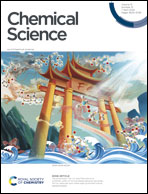Covalent crosslinking chemistry for controlled modulation of nanometric roughness and surface free energy†
Abstract
Smooth interfaces embedded with low surface free energy allow effortless sliding of beaded droplets of selected liquids—with homogeneous wettability. Such slippery interfaces display low or moderate contact angles, unlike other extremely liquid repellent interfaces (e.g. superhydrophobic). These slippery interfaces emerged as a promising alternative to extremely liquid repellent hierarchically rough interfaces that generally suffer from instability under severe conditions, scattering of visible light because of the hierarchically rough interface, entrapment of fine solid particulates in their micro-grooves and so on. However, a controlled and precise modulation of surface free energy and nanometric roughness is essential for designing a more compelling solid and dry antifouling interface. Here, we have unprecedentedly demonstrated the ability of covalent cross-linking chemistry for precise and simultaneous modulation of both essential surface free energy (∼49 mN m−1 to ∼22 mN m−1) and roughness (root mean square roughness from 30 nm to 3 nm) of a solid interface for achieving liquid, substrate, and process independent, robust slippery properties. The strategic selection of β-amino-ester linkage through a 1,4-conjugated addition reaction between amine and acrylate groups of a three component reaction mixture (dominated by a 61% (w/w) crosslinker) under ambient conditions provided a facile basis for associating various important and relevant properties—including self-cleaning ability, anti-smudge properties (against both water and oil-based inks), thermal stability (>300 °C), chemical stability, physical durability, optical transparency (∼95%) and so on. The embedded slippery properties of the coating remained unaffected at both low (0 °C) and high (100 °C) temperatures. Thus, the prepared coating would be appropriate to maintain the unperturbed performance of commercially available solar cell modules and other relevant objects under outdoor conditions.

- This article is part of the themed collection: Celebrating the scientific accomplishments of RSC Fellows


 Please wait while we load your content...
Please wait while we load your content...